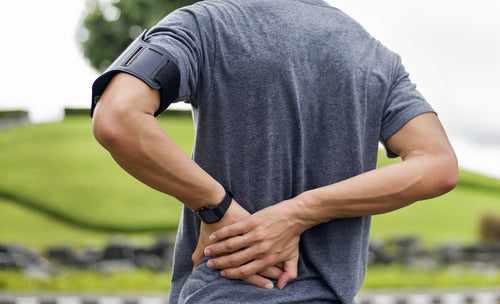8 Reasons Muscles Cramp or Spasm

Have you been having muscle cramps or spasms lately? If so, you may not be sure what is going on.
To clarify, muscle cramps and spasms are the same thing. Both of these names refer to contractions in your muscles which are involuntary.
Cramps and spasms can be painful. Sometimes, the pain is localized to the muscle which is cramping. Other times, it may refer to another location. For example, a spasm in your neck could lead to a headache.
If you have been having frequent spasms are cramps, you might want to check into the following possible causes which could be leading to you experiencing this symptom.

1. Low potassium, calcium, or magnesium.
Muscle contractions do not work properly without a balance of electrolytes. So, if electrolytes such as potassium, calcium or magnesium become imbalanced, you might experience spasms or cramps as a result.
Make sure that you are getting adequate levels of these nutrients in your diet. If you have other reasons to suspect suboptimal levels, consider checking them.
2. Exercising without a proper warm-up.
If you do not warm up properly before you work out, you might have cramps or spasms as a result.
The thing to know about this is that there are multiple schools of thought when it comes to how to properly warm up before exercising.
Some people feel that you should stretch first, and then engage in other exercises. But others believe that you should first do some kind of light aerobic activity before stretching.
Pay attention to how your own body reacts to different approaches. Over time, you should be able to figure out the least injurious approach to warming up and engaging in your regular workouts.
3. Working out when it is too hot and/or letting yourself get dehydrated.
One thing which can lead rapidly to an imbalance in your electrolyte levels is getting dehydrated.
If you lose too much water, you also end up losing electrolytes in the process. Even if you replenish your water, if you do not also remember to replenish those lost electrolytes, you might continue to experience cramps and spasms.
Try to avoid getting dehydrated when possible. Continuously drink more water and supplement your electrolytes on hot days, especially if you are exercising.
4. Being in one position for too long.
While you might end up getting cramps or spasms from exercising improperly (or from exercising at all, if you are particularly prone to these issues), the opposite is possible as well.
Somewhat counterintuitively, resting in one position for a long time without moving much can also lead to similar cramps and spasms.
In fact, anything which overloads a particular muscle could lead to involuntary contractions.
5. Medical conditions associated with narrowed arteries or compressed nerves.
Mayo Clinic writes, “Narrowing of the arteries that deliver blood to your legs (arteriosclerosis of the extremities) can produce cramp-like pain in your legs and feet while you're exercising. These cramps usually go away soon after you stop exercising.”
Mayo Clinic also states, “Compression of nerves in your spine (lumbar stenosis) also can produce cramp-like pain in your legs. The pain usually worsens the longer you walk. Walking in a slightly flexed position — such as you would use when pushing a shopping cart ahead of you — may improve or delay the onset of your symptoms.”
If you suspect that serious issues like these could be involved with the cramps you are experiencing, you should talk to a medical professional.
6. Myofascial pain syndrome.
Another condition which can cause spasming and cramping on a regular basis is myofascial pain syndrome (MPS).
Although a lot of people have never even heard of this condition, it is surprisingly prevalent. As explained here, MPS “accounts for 21% of orthopedic clinic visits, 30% of general medicine visits, and approximately 85% to 93% of pain management clinic visits.”
If you have this syndrome, you suffer from chronic active trigger points in your muscles, creating taut bands of tissue. Those trigger points are actually areas of muscle tissue which are stuck in an involuntary contracted state.
You may feel pain localized to affected muscles and/or pain referring to other parts of your body.
Unsurprisingly, the involuntary contractions associated with myofascial pain syndrome can lead to spasms and cramps.
These can be recurrent, and can manifest even when you are not doing anything in terms of working out or lying or sitting in an awkward position.
It can be extremely difficult or even impossible to relax the muscles in question when you have this condition, so spasms and cramps may be an ongoing part of your everyday life.
7. Psychological causes.
One particularly fascinating cause of muscle spasms is what is known as "benign fasciculation syndrome,” or BFS.
This is a psychosomatic condition which seems to manifest particularly when a person is fearful of developing a serious health condition which would cause such twitching.
As explained in this paper, "The anxious medical student, qualified clinician or other individuals (typically under 40?years of age) presenting with fasciculations is a common clinical encounter.”
So, someone reading up on severe health problems which could cause muscle spasms who becomes overly stressed about the possibility might actually start to display those symptoms. Pretty ironic, right?
8. Other disorders and/or unknown causes.
While I have mentioned a few medical conditions which might commonly result in spasms and cramps in your muscles on a frequent basis, this list is not exhaustive.
It is worth looking into other possibilities as well if you think that a different diagnosis may be a better fit for your signs, symptoms, and overall portrait of health.
Also, sometimes, the cause for muscle cramps or spasms may never be discovered.
What Can You Do About Frequent Muscle Cramps or Spasms?
If you are experiencing occasional muscle cramps or spasms, and you know that they are likely the result of improper exercising or electrolyte loss, some small adjustments to your lifestyle should help reduce instances.
But if you are experiencing muscle cramps or spasms on a frequent basis, you may want to talk to a medical professional to make sure that there is nothing serious you are overlooking.
If there is an underlying condition, treating it is the first step toward reducing the spasms and cramps, and may also be important for protecting other aspects of your health and well-being.






